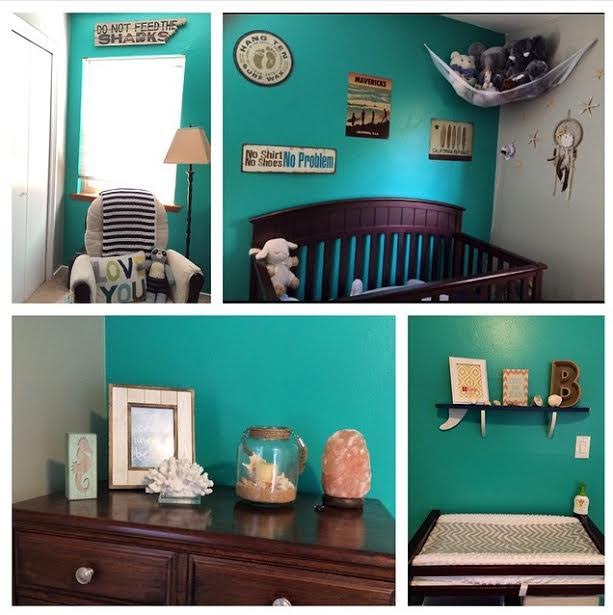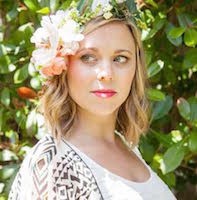
When I was pregnant, I could hardly wait to get started on the nursery.
I had an entire Pinterest board dedicated to design ideas, and had thoroughly planned out just how I wanted the nursery to look. I drove my husband crazy nagging him to get started on painting it so I could get busy “nesting.”
Not only did I want my son’s nursery to be aesthetically pleasing, I also wanted it to be safe and non-toxic. A sanctuary for him to sleep and play in. On my search for the perfect pieces to put into my son’s room, I found that many everyday products for infants and children, such as the mattresses they sleep on and the changing pads we wipe their little booties on, are made from harmful materials and contain toxic chemicals. These chemicals can let off gasses that are then inhaled while a child sleeps, sits, or lies on or near them. Fortunately, there are much safer, organic and non-toxic options now available!
In my research, I continued to see the same toxic chemicals popping up over and over again as components in many of the essential pieces that make up a nursery. Here’s a list of the most common, followed by the bedroom items they are found in, and the safe alternatives I’ve found.
Commonly used toxic chemicals that lurk in everyday baby products.
Polyurethane foam.
Used as filling for many crib mattresses and changing pads, polyurethane foam contains several toxic ingredients that emit harmful gasses such as formaldehyde, toluene and benzene, which I will mention below.
Formaldehyde.
A highly flammable substance, formaldehyde is also carcinogenic. Prolonged exposure to formaldehyde has been shown to cause headaches, depression and mood changes, insomnia, irritability, and can even lead to attention deficit disorders.
Toluene.
Also highly flammable, toluene is an inexpensive and very strong adhesive used by many different manufacturers for all kinds of products. It is what gives products that “new” smell when you open them. Regular exposure to toluene and the vapors it emits can damage the nervous system, lead to mental confusion, dizziness, headaches, drowsiness and fatigue, and skin problems.
Benzene.
A known carcinogen, benzene has been proven to increase one’s risk of developing leukemia. It is often used to make synthetic fibers and fabrics, detergents and dyes.
Polyvinyl chloride (PVC).
PVC is another known carcinogen that lurks in many different products from changing pads to baby bottles and more. However, many companies have come to realize that PVC is harmful and have stopped using it in their products. When buying supplies of your child, be sure to check that they are “PVC free.”
Volatile organic compounds (VOC).
VOCs are chemical compounds commonly used in paint that continue to off-gas long after the paint has dried. They have been known to cause several serious health problems ranging from ear, nose and throat irritations to severe headaches, and even cancer.
Where you might find these toxic chemicals and what to use instead.
Crib mattresses.
The problem: Many popular crib mattresses are filled with polyurethane foam and have been shown to emit over 100 different harmful chemicals and industrial solvents. Yuck! When your child sleeps on the mattress he or she inhales those chemicals. Not only that, but these chemicals are emitted into the air, causing you and your baby to be exposed to them every time you are in the room.
The solution: Opting for an organic crib mattress is one of the best things you can do to prevent your child from being exposed to these unnecessary and harmful chemicals. The best truly organic crib mattress I have found (and the one that is in my son’s crib) is the Naturepedic No-Compromise 2 in 1 Ultra Crib Mattress. It is 100% non toxic and organic. This mattress comes with two sides. One side is firmer (and waterproof!) for infants and the other side is quilted and a bit softer for toddlers.
Special note: When choosing an organic crib mattress, be sure to check what it is filled with. There are many brands that will claim their mattress is organic, and indeed the outer material is, but then they are filled with potentially harmful, non-organic stuffing or foam.
Mattress pads.
The problem: Similar to crib mattresses, mattress pads also are made from harmful, synthetic materials that your child inhales while they are sleeping, and they continue to off-gas harmful chemicals into the air as well. Many mattress pads contain PVCs, and are then coated with harmful antibacterial and stain-resistant coatings.
The Solution: Luckily, there are some great, all-organic (and waterproof) mattress pads available. Once again, Naturepedic wins as my choice for best organic crib mattress pad. They have several to choose from, including an organic cotton waterproof mattress pad made from 100% safe, non-toxic and organic materials.
Changing pads.
The problem: Changing pads may also contain polyurethane foam plus antibacterial, stain resistant coatings that off-gas harmful chemicals.
The solution: There are many organic brands to choose from, ranging in price from as low as $20 up to $200. I like (and use) the Oeuf Pure and Simple Eco-Friendly Contoured Changing Pad ($48-$55). Naturepedic also offers an excellent organic changing pad, however it is on the pricier side ($99).
Crib Bedding.
The problem: Choosing toxin-free crib bedding is personal and many things come into play such as the size, style, colors, and patterns. No matter what your style, be sure to select bedding made with clean materials. Try to steer clear of crib bedding made from synthetic fibers, as these can contain harmful chemicals and dyes, can irritate a baby’s sensitive skin and cause allergy like symptoms.
The solution: Many big name companies such as Land of Nod, Pottery Barn Kids, Sprout SF, and Giggle now carry a line of organic crib bedding. Etsy is an excellent place to find unique and fun patterns and styles of crib bedding made from super soft organic fabrics.
Paint.
The problem: Most wall paint contains harmful chemicals known as VOC’s.
The solution: Luckily, more and more paint companies now offer non-VOC paints in an array of beautiful shades. When choosing paint for your nursery, be sure to check that it is in fact “non”-VOC. Some paint companies claim to be low-VOC, but this is only the base paint, and once color is added it becomes a higher VOC paint. Non-VOC paints are easy to find at most home improvement stores.
Furniture.
The problem: The wood used to make cribs, changing tables, dressers, rocking chairs and bookcases are often treated with formaldehyde and other stains and sealants that off-gas harmful chemicals into the air. Synthetic materials such as plywood can be even worse.
The solution: When buying furniture for your baby’s nursery, look for used pieces, which will have lower levels of formaldehyde, than newer pieces. Formaldehyde tends to “settle in” after about 5 years and stops off-gassing at that point. Craigslist is always a great place to look for used furniture, as well as secondhand baby stores. If you really want something new, aim to find furniture that is finished with a non-toxic seal such as beeswax. Another solution is to use a product called Safecoat Hardseal on your new furniture to help cut down on off-gassing. Cover crib rails with rail guards to prevent your little one from chewing on the wood and ingesting any of the sealants and stains used on the crib.
Other items to consider adding to your nursery.
Himalayan Salt Lamp.
Rather than using a traditional night-light, using a Himalayan salt lamp not only gives off a warm, soft glow (proven to not interrupt sleep patterns like a white or blue light) but it also may provide health benefits! Himalayan salt lamps are thought to emit negative ions which are found in nature, created from ocean waves, waterfalls, lightning, and sunlight. Some research has shown that negative ions may help to increase serotonin, relieve stress, improve sleep, improve overall mood, increase daytime energy, and promote calmness. We use one in my son’s room, in our bedroom, and in our living room.
Cool mist humidifier.
I love the Crane Ultrasonic Cool Mist Humidifier, which we use every night during the winter in my son’s room. During the winter months the air tends to become drier, then add on top of that the use of furnaces and heaters that dry out the air in our homes even more. Dry air can lead to an increase in colds, congestion, runny noses, sore throats, dry itchy skin and eczema. Humidifiers help to protect against dry air by adding moisture back into the air. I prefer cool mist humidifiers because there is less of a chance of bacteria and mold growing in them and being released into the air.
Diffuser.
Diffusing essential oils can provide several health benefits, including promoting a more restful sleep, reducing stress, enhancing mood, and the list goes on. Diffusing high-quality, therapeutic-grade essential oils in your baby’s room not only makes the air smell nice, but also adds an additional health boost to the air they are breathing!
~
Author: Sarah Bradford
Photo: Courtesy of Sarah Bradford
Editor: Jean Weiss


 Share on bsky
Share on bsky




Read 1 comment and reply